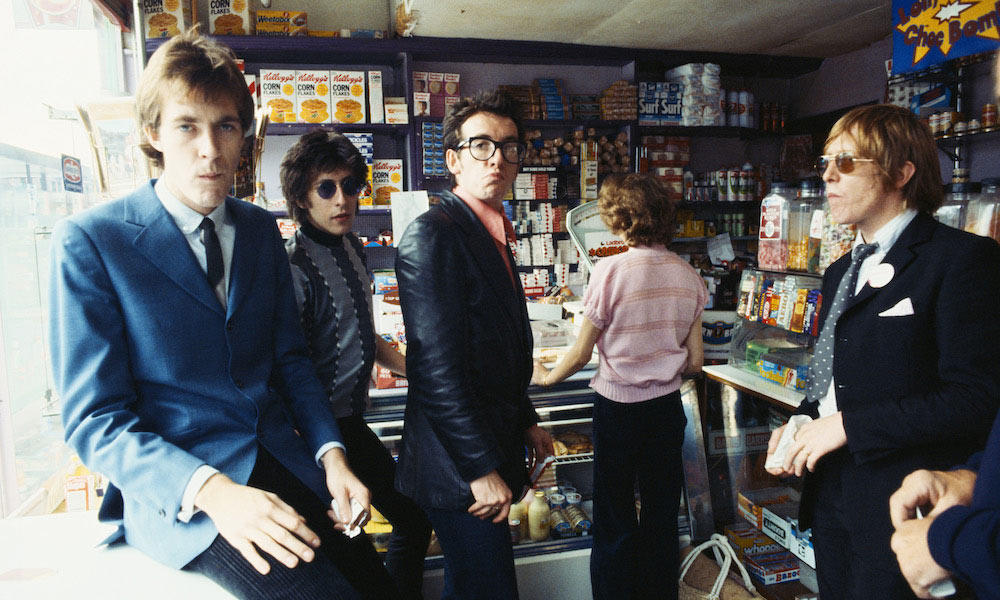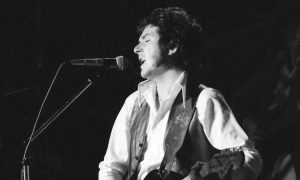Imagine that it’s 1979, and you’re hearing Elvis Costello & the Attractions’ Armed Forces for the first time. The first side would be one surprise after another. Compared to This Year’s Model, released only 10 months earlier, this was something new: complex arrangements, new instruments, denser production, and a heightened sense of melody. Then along comes the most surprising song of the lot: “Green Shirt.”
The Complete Armed Forces is out now.
If one song bore out the ground that Costello and the band traveled between albums, “Green Shirt” was it. This wasn’t raw punk rock by any means, instead, it did reflect Costello’s professed love for Kraftwerk and Berlin-era Bowie.
Emotional fascism
Costello was no longer the guy writing vengeful songs about past relationships from My Aim Is True and This Year’s Model, “Green Shirt” reached deeper, taking the innocent topic of an attractive woman on television and spinning it into a paranoid look at media lust as a form of mind control. Not for nothing, the album’s original working title was Emotional Fascism.
Lyrically, “Green Shirt” ties in well with the album’s theme of everyday cruelty: On the surface it’s about seeing a fashionable woman on television, feeling a bit seduced by her presence, then wondering what kind of mind-control is going on here.
The shirt in question apparently belonged to BBC newswoman Angela Rippon. Though Costello has never confirmed the reference, photographer Chalkie Davis has claimed he was with Costello at the BBC just after he’d played Top of the Pops, when Rippon walked by in a striking green shirt and Costello began writing down ideas. The Quisling Clinic reference was also real – it was a building in Madison, Wisconsin that the band drove past on tour – but its use for ominous experiments was a product of the songwriter’s imagination.
Fully wrapped in paranoia
By the song’s end, Costello is fully wrapped in paranoia: There’s a big investigation going on, and everybody’s under suspicion, but “you don’t want to hear about that” (and “you” could just as easily be the listener as the TV woman). The one consolation is that the broadcaster is as much a victim as everybody else.
“I’m not going to explain my songs,” Costello told Sounds in 1980. “If you can’t hear what’s going on from the song itself, then God help you. I’m not going to write a manifesto. I’m a better songwriter than that, surely.”
Years later, in the liner notes to the album’s first reissue in 2002, he did share the mindset that birthed the song: “Maybe the late hours and my chemical constitution were exaggerating the creeping threat, but the coincidences added the surreal edge into the sensory overload and the paranoid tone of ‘Green Shirt’. The thugs of the nationalist parties were parading in the streets of London.”
Surprising influences
That “emotional fascism” idea pervaded many of the songs on Armed Forces – and if that sounds heavy, well, it was. But the music was light on its feet. Not for the last time, Costello and the Attractions took a cue from their musical passions at the time, which included ABBA and The Beatles, along with the above. None of this was served straight-up, but the influence was there. Punk was out, lush melodies and jittery rhythms were in. More often than not, the smoother sounds were used to ironic effect.
Just as impressive was the work of producer Nick Lowe, who’d been famous for making live-sounding records; his quotable motto was “Bash it out now, tart it up later.” On this album, he spent plenty of time on the latter, layering sounds into exotic combinations. Meanwhile, Lowe remained great at capturing the charge of a great rhythm section: Whatever happens on top, the pounding of bassist Bruce Thomas and drummer Pete Thomas remains vivid and vital.
They’re especially strong on “Green Shirt,” the album’s most adventurous track. Melodically the song is sprightly enough to bear out that ABBA influence, but the song’s real hook is the bass/drum quadruplet that comes down like a blow to the head after every lyric line: “You can please yourself, but somebody’s gonna get it,” leaving Pete Thomas to drive it home with a well-placed hit on the ride cymbal.
Steve Nieve keeps a pulsing rhythm on a sequencer and plays lead on the Minimoog, an instrument he hadn’t used in the past – and seldom would again. Unique among rock’s first-division keyboardists, Nieve has largely remained a staunch piano-and-organ guy.
Musical synchrony
According to Costello, the recording process for “Green Shirt” wasn’t that much different from anything on This Year’s Model. Both were recorded at Eden Studios in London and as Costello said in the original liner notes, “It seemed as if we were making an impossibly sophisticated leap from the sound of This Year’s Model, but listening now there are very few production devices that sit between the listener and the songs.”
What you’re really hearing is the synchrony of him and the Attractions as a band. Listen to the original solo demo of “Green Shirt,” which appears on the new Armed Forces reissue, and you’ll hear how far it came: The tension and the tune were there, but the jittery rhythms, pulsing synths, and drum hook all came in once the band got hold of it. “We probably never had quite this level of consistent musical agreement again,” Costello wrote.
Though “Green Shirt” became a fast fan favorite, it wasn’t a single and got precious little US airplay – but then, obvious classics like “Accidents Will Happen” and “(What’s So Funny About) Peace, Love & Understanding” weren’t all over the radio either. Save for a handful of adventurous stations, FM radio in America was still terrified of anything New Wave, with only a few token tracks by the Cars, the Knack, and Blondie. They stayed away even when the album was a hit, and Armed Forces was one, making the US album chart at No.10, the best showing of Costello’s entire career.
“Green Shirt” would have a long tenure as a live number; it was still in the setlist for his last pre-shutdown show with the Imposters in London in March. The expanded edition of Armed Forces also features a live version from the Pinkpop Festival in the Netherlands, when the album had only been out a few months and the crowd was still hearing it fresh. Fans warmed to it soon enough; when Costello began playing it in his acoustic sets, and audiences would bang on their knees, their seats, or anything else within reach to fill in that drum riff.
In later years, the song would also take on a notable change of lyric: In the recorded version the words are “She’s listening in to the Venus Line, she’s picking out names, I hope none of them are mine.” That meaning is clear enough: Whatever mating ritual the TV woman is doing, the singer wants no part of it. Later on, the lyrics were changed to, “I hope all of them are mine,” and that one changed word made all the difference: There’s a possible bit of warmth, a definite bit of lust, and a willingness to join those mating rituals after all.




